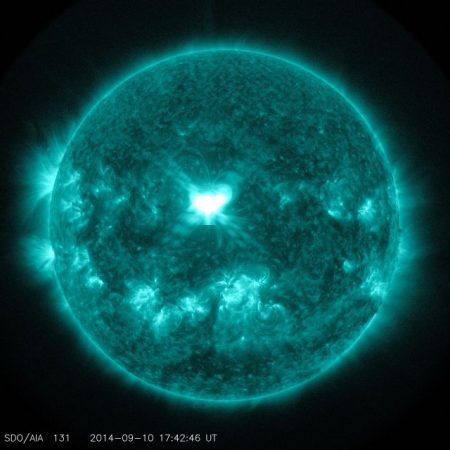April 5, 2017 – In the years 774 to 775 Charlemagne, the Frankish king, defeated the Lombards in Italy on the way to establishing a new so-called Roman Empire in Western Europe. But that historic event pales when compared to the cosmological one that happened over the same two years. One can even speculate that Charlemagne owes his Italian conquest to the Sun.
In a paper entitled, Atmospheric impacts of the strongest known solar particle storm of 775 AD, appearing in the March 28, 2017, issue of Scientific Reports, the contributing authors from the Davos World Radiation Center, Swiss Federal Institute of Technology, University of Oulu, Australian Antarctic Division, Universtiy of Tasmania, University of Bern, Ioffe Physical-Technical Institute, Nagoya University and University of Florence, describe the evidence for a solar energy particle (SEP) event of such magnitude that it caused an enormous spike in radioactive Carbon 14 captured in tree rings, changes to ice core composition collected at both poles, and profound impacts on Earth’s ozone layer for two years.
How can a SEP event affect atmospheric chemistry? And what does that mean for the people, animals, and plants at the time of the event?
Theoretically, SEP events should cause ionization of nitrogen and oxygen. The researchers looked for evidence of nitrate spikes in the polar ice but didn’t find any. But what they did find is evidence of changes in weather as recorded from historical records of the time. Modeling of the impact on the ozone layer suggested there should be evidence of changes to mean average temperatures in the northern hemisphere, a decline by as much as 4 Celsius (7.2 Fahrenheit) degrees. This could have produced polar vortices of unusual duration over Europe, Siberia, and Canada. Could this have affected spring plantings and harvests in these areas after the SEP event? Could the defeat of the Lombards have been a consequence of a climate changing event of short duration?
The authors of the paper describe a similar extreme SEP event from 993 to 994 AD. Fluctuations in Carbon 14 similar to that in 774 to 775 confirm the likelihood of a large solar proton or short gamma-ray burst emanating from the sun during that period. Historical references describe significant red auroras seen in Korea, Germany nad Ireland during 993. And further confirmation of a SEP at that time is evident in the atmospheric chemistry of ice cores.
Since those two events, we haven’t had anything similar of the same magnitude. In 1859, a recorded solar flare disrupted telegraph service around the globe. This is the only known SEP event to strike Earth during industrial times. Witnesses at the time described significant auroras in the Rocky Mountains, so bright that campers woke up thinking it was morning.
Where we can have some influence over Earth’s climate, through the controlling of greenhouse gas emissions from our industrial civilization, we have no means to stop a SEP from disrupting the planet’s climate as well as our satellite-based technology, telecommunications networks, and power grids. We can prepare for it by hardening our satellites and land-based networks.
Today we are just beginning to address the challenge of space weather. We would have about 12 hours notice to deal with a SEP event which could not only disrupt energy and telecommunications networks but also because of magnetized and charged particles potentially impact water and sewer pipes, destroy computer data, compromise military and security operations, and impact humans in near-Earth space let alone on the Moon or elsewhere in the Solar System. States Daniel Baker, Director of the Laboratory for Atmospheric and Space Physics, University of Colorado-Boulder, “once systems start to fail, (the outages) could cascade in ways we can’t even conceive.”
Lloyds of London has estimated that a large SEP event could impact Earth for up to two years and create damage costs of up to $2.6 trillion U.S. A senior analyst at FEMA, the U.S. agency responsible for responding to emergencies recently stated, “we know there is a gap in our ability to assess vulnerability and consequences.”
NASA currently, in cooperation with other space authorities, operates a number of solar observation satellites to capture changes to the Sun. STEREO, the Solar Terrestrial Relations Observatory was launched in 2006 and provides unique views of the Sun-Earth system. Hinode, also launched in 2006, is studying the magnetic properties of the Sun’s photosphere and corona. The Solar Dynamics Observatory, launched in 2010, is studying solar variations and their impact on life on Earth and our technological civilization.









